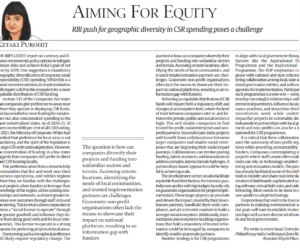Topic 1 : Revamp of Internal Oversight Mechanism for Official Data in India
Why in News ?
- The Government has taken significant steps to address “data quality issues” and improve the oversight of official data.
- To achieve this, the Standing Committee on Economic Statistics (SCES) has been revamped and replaced by a new Standing Committee on Statistics (SCoS) with broader responsibilities.
Establishment of the SCoS
- In response to the concerns raised after the rejection of findings from previous household surveys on consumption expenditure and employment, the Statistics Ministry issued an order to constitute the Standing Committee on Statistics (SCoS).
Unlike its predecessor, the SCoS will review the framework and results of all surveys conducted under the National Statistical Office (NSO).

Leadership and Membership
- Pronab Sen, the former Chairman of the National Statistical Commission (NSC), has been appointed as the chair of the newly established SCoS.
- The committee comprises 10 official members and four non-official members, who are eminent academics.
- It can have up to 16 members, as per the Ministry’s order.
Enhanced Terms of Reference
- The SCoS has been given “enhanced terms of reference” compared to the SCES to ensure wider coverage.
- Its mandate includes reviewing economic indicators and all surveys conducted under the NSO.
- The committee will advise the Ministry on technical aspects, such as survey design, sampling frame, methodology, and finalization of results.
Addressing Data Gaps and Improving Outcomes
- Apart from addressing issues related to survey results and methodology, the SCoS will also focus on identifying data gaps in official statistics and developing strategies to fill those gaps.
- It has been tasked with exploring the use of administrative statistics to improve the quality of data outcomes.
Role of the National Statistical Commission (NSC)
- While the SCoS will assist in finalizing survey results, the ultimate authority to approve the publication of those results lies with the National Statistical Commission (NSC).
Background and Critics
- The decision to revamp the oversight mechanism comes amid sharp criticisms of India’s statistical machinery by members of the Economic Advisory Council to the Prime Minister, including Bibek Debroy, its chairman.
- Debroy had previously advocated for a complete overhaul of the system and highlighted the lack of expertise in survey design within the Indian Statistical Service.
Conclusion
The establishment of the Standing Committee on Statistics (SCoS) marks a significant step towards improving the quality and reliability of official data in India.
With a broader mandate and expertise from various fields, the SCoS is expected to play a crucial role in enhancing the country’s statistical capabilities and addressing data quality concerns.
Topic 2: Kuno National Park
- Location: Kuno National Park is located in the Sheopur district of Madhya Pradesh. It is part of the Khathiar-Gir dry deciduous forests ecoregion.
- Size: The park covers an area of 748.76 square kilometers. It derives its name from Kuno River.
- History: The park was established as a wildlife sanctuary in 1981, and was upgraded to a national park in 2018.
- Biodiversity: Tigers, leopards, sloth bears, hyenas, jackals, wild boars, and deer. The park is also home to a number of bird species, including peacocks, eagles, hawks, and owls.
- Ecosystem: The park is a major water source for the surrounding area. It is also home to a number of tribal communities.
- Conservation: Kuno National Park is an important wildlife sanctuary. The park is facing a number of challenges, including poaching, habitat loss, and climate change.
Kuno National Park and the Cheetah Reintroduction Project
- The Kuno National Park is one of the sites identified for the reintroduction of cheetahs in India.
- The project is being undertaken by the Wildlife Institute of India and the Wildlife Trust of India.
- The cheetah is an endangered species that was once found throughout India. However, the species became extinct in India in 1948 due to habitat loss and poaching.
- The Kuno National Park is considered to be an ideal habitat for the cheetah reintroduction project. The park has a large prey base, including deer, nilgai, and wild boar. The park is also well-protected, with a strong anti-poaching force.
- The cheetah reintroduction project is a major conservation initiative.
- The project has the potential to help the cheetah recover in India and to raise awareness about the importance of wildlife conservation.
Conclusion
The park is facing a number of challenges, but it is also home to a variety of wildlife and is an important part of the Khathiar-Gir dry deciduous forests ecoregion. The cheetah reintroduction project is a major conservation initiative that has the potential to help the cheetah recover in India.
Topic 3: Cluster Bomb

Introduction:
- Cluster bombs, also known as cluster munitions, are a type of explosive weapon used in armed conflicts.
- These munitions are designed to disperse numerous smaller submunitions (bomblets) over a wide area, maximizing their destructive impact on both military targets and surrounding civilian areas.
- While cluster bombs have been used by various countries for decades, they have become a subject of humanitarian concerns due to their indiscriminate nature and long-lasting effects on civilian populations.
Working Mechanism:
- Dispersion: A typical cluster bomb consists of a container filled with hundreds of smaller bomblets. When dropped or launched, the container opens mid-air, dispersing the bomblets over a wide area.
- Coverage: Each cluster bomb can cover an extensive territory, making them useful for attacking large concentrations of enemy forces or infrastructure.
- Secondary Threat: The use of cluster bombs creates a secondary threat, as some bomblets might fail to detonate upon impact, remaining unexploded on the ground. These unexploded ordnances (UXOs) pose a grave danger to civilians, especially children, who might mistake them for harmless objects and accidentally trigger them.
Humanitarian Concerns:
- Indiscriminate Nature: The main humanitarian concern with cluster bombs lies in their indiscriminate nature. Due to the wide dispersal pattern and large number of bomblets, it is challenging to control their precise target, leading to a significant risk of hitting civilian areas and non-combatants.
- Civilian Casualties: The use of cluster bombs in populated areas has resulted in numerous civilian casualties. Children, in particular, are vulnerable to UXO accidents, causing severe injuries or fatalities.
- Long-Term Impact: Cluster bombs can have long-lasting effects on affected communities. UXOs can remain dangerous for many years after a conflict has ended, hindering post-war recovery and development efforts.
Some of the dangers of cluster bombs:
- They are indiscriminate weapons that can kill or injure civilians, including children.
- They have a high dud rate, meaning that many of the submunitions do not explode on impact. These duds can lie around for years, posing a danger to anyone who comes across them. Ex. Vietnam
- They can be used in populated areas, causing widespread death and injury.
- They are difficult and expensive to clear, which can hamper the recovery of a country after a conflict.
International Response:
- The Convention on Cluster Munitions: Recognizing the humanitarian concerns associated with cluster bombs, an international treaty called the Convention on Cluster Munitions (CCM) was adopted in 2008. The CCM seeks to ban the use, production, transfer, and stockpiling of cluster munitions.
- Participation and Compliance: Many countries have joined the Convention on Cluster Munitions, committing to the treaty’s objectives. States that have ratified the treaty are obligated to destroy their stockpiles, clear affected areas, and assist victims of cluster munitions.
Challenges:
- Non-Participating States: Some countries with significant military capabilities have not yet joined the Convention on Cluster Munitions, leading to ongoing use and stockpiling of these munitions.
Example- Russia, Ukraine , USA, India , Pakistan
- Stockpile Destruction: Destroying existing stockpiles of cluster bombs can be a complex and expensive process for some nations.
Conclusion:
Cluster bombs have emerged as a contentious issue due to their indiscriminate nature and the long-lasting impact they have on civilian populations.
The international community’s efforts to address the humanitarian concerns associated with these munitions have led to the Convention on Cluster Munitions, a significant step towards curbing their use and minimizing civilian harm.
As the world continues to grapple with the consequences of cluster bomb usage, it remains essential for nations to cooperate, comply with international treaties, and invest in efforts to clear affected areas, safeguard civilians, and prevent future use of these lethal weapons.
Topic 4: China-Russia Exercise

- Location : Sea of Japan also known as East Sea
- Aim of exercise is : To Safeguarding Security of strategic waterways
- Exercise code named as : Northern Interaction 2023
Related Info:
Kiribati

- An island country of Micronesia sub region of Oceania in central Pacific Ocean.
Gromkiy and Sovershenniy
- These are advanced Russian warships which will be taking part in this exercise.

Topic 5: Climate change and its effect on ocean
Climate change is the long-term shift in temperatures and weather patterns, mainly caused by human activities, especially the burning of fossil fuels. Climate change has various effects on the ocean, which covers about 70% of Earth’s surface and plays a large role in regulating Earth’s climate and environment.
Major effects of climate change on the ocean are:
Ocean warming:
- The ocean absorbs about 90% of the excess heat generated by rising greenhouse gas emissions trapped in the Earth’s system.
- This causes the ocean to warm up, which leads to various impacts such as ice melting, sea level rise, marine heatwaves, coral bleaching, and changes in marine biodiversity.
Ocean acidification:
- The ocean also absorbs about 30% of the carbon dioxide emitted by human activities.
- This causes the ocean to become more acidic, which affects the ability of many marine organisms to build shells or skeletons, and alters the chemistry of seawater.
Ocean deoxygenation:
- As the ocean warms up, it becomes more stratified, meaning that the layers of water do not mix well.
- This reduces the supply of oxygen to the deeper layers of the ocean, where many marine animals live.
- Low oxygen levels can cause stress, suffocation, or death for many marine species.
Ocean circulation:
- The ocean currents are driven by differences in temperature, salinity, and density of seawater.
- Climate change can alter these factors, which can affect the strength and direction of ocean currents.
- For example, the melting of ice sheets can add freshwater to the ocean, which can weaken the Atlantic meridional overturning circulation (AMOC), a major current that transports heat from the tropics to the North Atlantic.
- These effects of climate change on the ocean have significant consequences for marine ecosystems and human societies that depend on them.
- For example, sea level rise can increase coastal flooding and erosion, marine heatwaves can cause mass mortality of marine organisms, coral bleaching can reduce the diversity and productivity of coral reefs, ocean acidification can impair fish growth and behavior, ocean deoxygenation can reduce fish catches and biodiversity, and ocean circulation changes can affect regional climate and weather patterns.
Some possible actions include:
– Promoting renewable energy sources and energy efficiency
– Reducing deforestation and enhancing carbon sinks
– Implementing policies and regulations to limit carbon emissions
– Supporting research and innovation on climate change mitigation and adaptation
– Raising awareness and education on climate change and its effects on the ocean
– Enhancing cooperation and coordination among countries and stakeholders
– Protecting and restoring marine habitats and biodiversity
– Improving monitoring and forecasting of ocean conditions
– Developing and implementing adaptation strategies for coastal communities and sectors
– Promoting sustainable use and management of marine resources
Source: DTE
Promoting Equitable CSR Funding for Climate and Social Goals in India

What in News ?
- The Reserve Bank of India’s latest report on currency and finance highlights the importance of mitigating climate risks and achieving India’s net-zero goal by 2070.
- One of the recommended policy options is the mandatory geographic diversification of corporate social responsibility (CSR) spending.
- While this suggestion aims to create a more balanced distribution of CSR funds, its implementation requires a significant shift in the ecosystem to ensure a fair allocation of resources.
- Currently, CSR funds are concentrated in industrialized states, leaving many regions underserved.
- Overcoming this preference for local spending necessitates regulatory change, enhanced partnerships, and the utilization of technology-enabled monitoring and evaluation models.
- Concentrated CSR Funding: Challenges and Impact
- As per Section 135 of the Companies Act, companies tend to deploy CSR funds preferentially to areas near their business operations, resulting in concentrated spending in a few industrialized states.
- This approach has led to more funding for social issues but has also exacerbated regional disparities in development. By 2020-21, 10 states received 80 percent of all CSR funding, leaving other regions underserved and neglected.
- Regulatory Shift and Ecosystem Changes
- To achieve an equitable distribution of CSR funds, a regulatory shift is necessary.
- The spirit of the Companies Act encourages alignment with national priorities rather than focusing solely on local areas.
- Companies must be encouraged to diversify their projects and funding into unfamiliar sectors and terrains.
- Trust among companies, non-profits, and government sectors needs to be elevated, enabling partnerships and collaborations to address complex challenges on a pan-India scale.
- Promoting Trust-Based Partnerships
- Successful diversification of CSR funds requires building trusted partnerships with for-profit, social enterprises, and grassroots non-profit organizations.
- Collaborations between larger corporations and smaller social enterprises can pool funding, talent, resources, and innovations to address intersecting challenges.
- Additionally, larger non-profits can promote and elevate the impact of smaller partners, acting as trusted conduits and helping them with compliance to build a stronger social ecosystem.
- Leveraging Government Initiatives
- Aligning CSR programs with government initiatives like the Aspirational District Programme and Aspirational Block Programme fosters collaboration among local, state, and national governance entities.
- Participation in such programs enables companies to undertake impactful projects in vulnerable districts while influencing local governance practices and streamlining administration work. Independent partnerships with local governments and non-profits can also be an effective approach.
- Balancing Autonomy and Accountability
- Collaborations between corporations and non-profits must strike a balance between maintaining the autonomy of non-profit organizations and providing accountability to the funders.
- Technology-enabled monitoring and evaluation models can play a crucial role in this regard, especially for remote projects where staff cannot frequently make field visits.
- Real-time data transfer, dashboards, accounting software, virtual field visits, and video conferencing facilitate effective monitoring and evaluation.
Conclusion:
Achieving India’s net-zero goal and addressing climate risks requires an equitable distribution of CSR funds.
The current concentration of funding in industrialized states can be overcome through regulatory changes and ecosystem-level shifts. Building trust-based partnerships, leveraging government initiatives, and adopting technology-enabled monitoring and evaluation models will enable corporations to be true national partners in realizing environmental and social goals.
By embracing these strategies, India can progress towards a more balanced and sustainable future, ensuring that no region is left behind in the pursuit of inclusive development and climate resilience.

